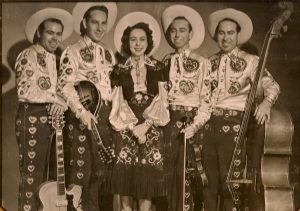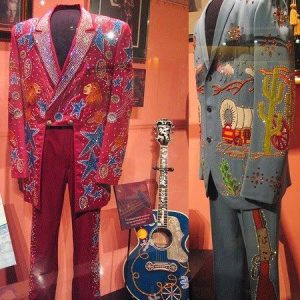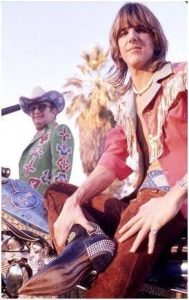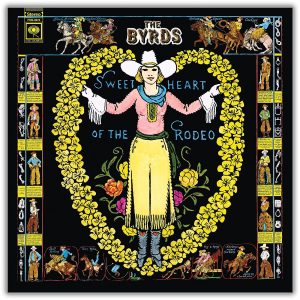Cosmic Americana: Nudie Cohn's Visionary Fashion Expressed the American Ethos
From rodeo queens and Rhinestone Cowboys to rock & roll-folk exploding dreamers, Nudie Cohn expressed a certain kind of American ethos. What better thread through the history of the West and the singers and entertainers who epitomized it in the mid-20th century, is found in the razzle-dazzle fusion of American sounds and cultural traditions of Cosmic Americana.
By Jenna Stocker
The Cosmic Americana American Dream. Addicted to the synergy of excess and success. All that glitters in the eyes of dream chasers and shit talkers and take-no-prisoners scrappers who wake up each day teetering on the precipice between fame and the ash heap of back-alley history. America is home to some of the greatest innovators and go-getters, self-made men, and Fate’s sacrificial suicides. The greatest of them all have stories that endear themselves to the very soul that makes America what it is — and still is if one takes the time to sort through the maddening, increasingly complicated layers of societal rules. “It’s better to be looked over than to be overlooked,” the famous quote from Nudie Cohn, creator of the Nudie suit, clothier to cowboys and rodeo competitors, designer to the men and women who shaped popular culture and formed modern Americana into the stuff of legends. His story and those of his contemporaries and their heirs elevate the American Tale into one of sparkling mysticism and rhinestone glory.
Rodeo Ben, Nudie Cohn, Nathan Turk, Manuel Cuevas, Jaime Castaneda, with their impeccable talent for combining artistry and skill, made the icons — first of country western, then imbued through nearly every genre of Americana — shine brighter.
Immigrants to America early in their lives, learning and honing their craft with a myriad of influences but retaining the flavor of their respective homelands, and striking out on their own with a singular vision as cowboys rode through their dreams over a soundtrack composed of hillbilly blues and western swing.
The pioneers of what would eventually be popularly known as the “Nudie suit” shared strikingly similar stories: Jewish immigrants to the New World perfecting their tailoring skills to serve an American clientele increasingly immersed in the cowboy culture of post-war America. “Rodeo Ben” Lichtenstein found his place in 1930s Philadelphia. His Rodeo Ben storefront eventually grew into a coast-to-coast mail-order catalog that promised perfection in western and rodeo wear. His reputation for finely tailored outfits and western-style suits — worn by those on the rodeo circuit along the Atlantic coast dazzling the imaginations and rousing the crowds of city slickers hungry for western culture — caught the attention of denim manufacturer Blue Bell in 1947, who commissioned Ben to design a pair of denim jeans to be made under the name Wrangler. And so was born the 11MWZ, or famous “Cowboy Cut” jeans (now labeled 47MWZ) — still a best seller for the brand.
The story of the whole crew of rodeo tailors that proceeded Rodeo Ben is almost too good to be true, life imitating art or just a passion and belief so embedded in one’s soul that these men willed it into existence.
Like Rodeo Ben, Nathan Turk came to America from Poland but settled on the Pacific coast in Los Angeles, opening his own dry cleaning and alterations shop on Ventura Boulevard, nestled in with the movie studios, turning out westerns that the nation was craving. Soon he was dressing Gene Autry and Roy Rogers, the Maddox Brothers & Rose, and Buck Owens.
But in the hands and imagination of Nutya Kotlyrenko (who changed his name to Nudie Cohn), the Singing Cowboy would explode onto the American scene reborn as the Rhinestone Cowboy. Cohn started in New York City refashioning costumes for burlesque dancers by incorporating rhinestones into their outfits. Moving west with his wife and business partner Bobbie, he opened a North Hollywood shop, Nudie’s Rodeo Tailors. Captivated by the westerns he watched as a boy, coupled with the western music clubs he and his wife would frequent at night, Cohn immersed himself in the culture of the rodeo show under the gaze of the Hollywood sign. It was a match for the ages and what was born — what is now commonly referred to as the Nudie Suit — is the embodiment of cultural crossover, the entertainment lifestyle of excess and the lure of fame, and the realization that some things can indeed live forever.
Before his death in 1984, Cohn designed his custom suits for icons such as Hank Williams, Johnny Cash, Roy Rogers, Glen Campell, Dolly Parton, Elton John, Bob Dylan, John Wayne, Tex Williams, David Cassidy, John Lennon, and Cher. He created Elvis Presley’s gold lamé suit for the album 50,000,000 Elvis Fans Can’t Be Wrong.
But neither the look nor the lifestyle would die with Cohn. Besides successors who had worked with him, like Cuevas and Castaneda, the indelible mark of this reimagined western America would be carried out by Gram Parsons. Somewhere in the impossible-to-trace cultural cross-pollination taking place in the 1960s, Nudie’s Rodeo Tailors was more than just a place to buy rodeo-style shirts and custom suits. It was a cauldron of creatives, entertainers, drugs, and music. What emerged was a magic elixir, a cultural brew, that cast an unlikely mix of people and personalities under its spell.
A one-semester Harvard man, Parsons escaped his personal tragedies and indulged his love and talent for music by performing in New York with different bands. He eventually joined the Byrds, a fateful entry into music lore that would be a defining moment in an era filled with ground-breaking cultural, social, and political shifts.
With their 1968 album Sweetheart of the Rodeo, the Byrds did with Country-Rock what they previously did for Folk-Rock: use their skilled musicianship and influence to introduce two genres of music — and their acolytes — to each other. Barry Gifford reviewed the album for Rolling Stone:
The dedication to simplicity is reflected best on “I Am A Pilgrim,” a really sweet song rearranged by Roger (Jim) McGuinn and Chris Hillman. It includes only one minor repeated guitar run and the rest of it is reminiscent of Dylan’s uninspired folk-strumming of “The Times They Are A-Changin’” days. “Blue Canadian Rockies” is a particularly nostalgic track for all old Gene Autry fans. To hear that “the golden poppies are bloomin’/’round the banks of Lake Louise” brings back visions of Ol’ Gene and his horse Champion loping along the prairie.
It was Gram Parsons who was the spark that transformed the glowing embers into a blazing fire. When Parsons and Byrds bandmate Chris Hillman parted ways with band leader Roger McGuinn, those first wisps of a Country-Rock fusion came together in their new group The Flying Burrito Brothers — a culmination of quintessential American sounds: Rock & Roll, blues, gospel, Appalachian country, bluegrass, Country & Western, and Depression-era folk. Parsons would later baptize it Cosmic Americana.
Hillman writes about the earliest days of the new band in his 2020 memoir Time Between:
Traditional bluegrass music was my first love, and from that first day at Bill Smith’s house in 1961, that music had only become more ingrained in me as a player, singer, and songwriter. Since Gram and I shared a common vision to bring real country music to a rock audience with a hip sensibility, we agreed it would make sense for us to join forces and carry on from where Sweetheart left off. With that common vision, we had forged an instant partnership. We just needed a band and a record deal…
Growing up watching the country music shows broadcast live out of Los Angeles in the late ‘50s and early ‘60s, I was always drawn to the clothes the performers wore. Their rhinestones and exaggerated embroidery made for an unforgettably multidimensional musical and visual experience. There were two main western tailors in LA back then: Nathan Turk and Nudie Cohn. I think Turk may have been around before Nudie, but each possessed his own individual style. Eventually, the striking “Nudie suits” became even better known than Turk’s creations and — with the advance money from our new recording and publishing deals freshly in hand — Gram and I decided to recruit Nudie to outfit the group. To me, real country music included rhinestone suits, so I was really excited the day that Sneaky, Chris, Gram, and I drove over to Nudie’s shop on Lankershim Boulevard in North Hollywood to order our own.
The influence of the West, like a ghostly specter that haunts our imagination and whispers a defiant spirit into our traditions is still seen and heard today. The Cosmic American Music Festival was held annually from 1996 to 2006 in Joshua Tree, California in honor of Parsons (read about the events surrounding his death to understand the symbolism of that place, you won’t be disappointed). In addition to honoring Parsons, performers were encouraged to undertake the spirit of innovation and creative exploration. The Counting Crows, Emmylou Harris, the Rolling Stones, the Jayhawks, Lucinda Williams, Charley Crockett, Old Crow Medicine Show, even Taylor Swift and the latest Bruce Springsteen album signal an evolving musical sound that still harkens back to western roots.
But what strikes a stunning picture of how this genre lives on in the most unlikely places is on whom we see it: rapper Post Malone, modern country singer Miranda Lambert, and electronic artist Diplo. Singer-songwriter Elle King (who is also the daughter of comedian Rob Schneider) wore a Nudie-style suit when she hosted CBS’ New Year’s Eve Bash this year in Nashville. The 2019 remix by rapper Lil Nas X and Billy Ray Cyrus, “Old Town Road,” featured both men wearing Nudie-style suits in the viral music video. The song sold over 18 million records worldwide — one of the best-selling singles to date. And thus was born country…rap? But Nudie’s style continues to be reimagined and repurposed throughout the entertainment industry and in American culture. Jerry Lee Atwood and Joe Walters of Union Western, Judith Pierce, and Fort Lonesome are carrying on the Nudie tradition.
In a time and a country that seems siloed in interests, and division seems stronger than ties, while corporate homogenization has smothered the remnants of brashness, the exceptionally unique, or the endearingly odd like a wet blanket, there is an underlying force in America that refuses to die. Although rumors of its death are often reported, especially among the tony sophisticates and finger-to-nose intellectuals, it returns to life in a fit reminding us all that we cannot so easily shrug off what is woven in our souls.
It is the Western ethos. It is Americana. And for every attempt at rewriting history, vilifying America’s past, or streamlining thought, speech, and culture, there are nuggets of gold proving this country is still rich with traditions, grit, swagger, and dogged determination all undergirded by the Wild West tamed by hard men in tough times to build a foundation for the American Dream.
What it says, too, is that this side of American culture, whether or not it was created at the tables in Hollywood backlots by men chain-smoking their way to the next feature or in the imaginations and gold-plated myths of those seeking a simple life — the mid-century optimism, the blazing trails, the embrace of the Western aesthetic and unabashed stoic-rebel cowboy mentality, is still alive and well and loved.
There’s no better example of all these things — ultimately culminating in what we can now call Americana — than the rodeo tailors, Nudie Cohn, Americana, and the cultural reverberations and influences we still see and hear today.
“A man is as big as his dreams are. If you want to make big tracks on the land, you got to step out and start walking.”
― Louis L’Amour, How the West Was Won
“Cosmic Americana: Nudie Cohn’s Visionary Fashion Expressed the American Ethos” ©2025. Jenna Stocker and The Renaissance Garden Guy
Jenna Stocker is an editor and writer living in Minnesota with her husband and two small children, dogs, chickens, and fish. She exists between a mid-20th-century dreamscape and the American West, a little bit country and a little bit rock and roll. You can find her on X @JennaLynn88.
The Renaissance Garden Guy is a participant in the Amazon Associates Program. As an Amazon Associate, The Renaissance Garden Guy earns from qualifying purchases.
Additionally, The Renaissance Garden Guy is a participant in the Bluehost, SeedsNow, and hosting.com (formerly A2 Hosting) affiliate programs. The Renaissance Garden Guy earns a fee/commission each time a visitor clicks on an ad or banner in this site from one of these companies and makes a subsequent qualifying purchase.
Please click here to view The Renaissance Garden Guy Disclosure page.









Absolutely fascinating. An eye-opener on the American culture and fashion. Very interesting and well written.
🌸🌼🌺🙏
I agree, Roxxy. The degree to which this style has permeated and impacted American cultural and societal mores is amazing. The piece was fascinating. Ms. Stocker’s research skills and sensitivity to the paradigm are remarkable. Thanks for giving this one a read, Roxxy, and for commenting. I’m so glad you’ve enjoyed it.
Thank you for following along, Roxxy! I appreciate the kind words and am glad you connected with it. I learned so much researching and writing this one. It’s a great American story.
Great essay! Fashion’s connection to, and influence on, American culture is profound. Thanks for reminding the reader about this fascinating fashion pioneer who helped create the open and diverse culture that we as Americans enjoy today.
Thank you for reading and commenting, Kevin. Jenna’s observations are spot-on. The impact of the work of these fashion pioneers has been remarkable and deceptively pervasive. These are cultural game changers on so many important levels.
Thank you so much for reading, Kevin! It was as much fun researching this as it was to write. I’m glad you enjoyed it.
I really loved this piece – so well written, and such a fascinating history about a topic that I had never explored, or even considered, before now. I’m quite looking forward to seeing more from Ms. Stocker!
I absolutely agree, Ann. It’s a deceptively esoteric topic, but author Stocker has done a remarkable job of underscoring the style’s profound and pervasive societal and cultural impact – and, ultimately, that of its impetus. I’m with you 100%, Ann: I’m looking forward to more work from Jenna Stocker.
Oh gosh, Ann. Thank you. I wish I could write as lovely as the Nudie Suits were crafted, but I hope in some small way I did them and the culture around them justice. Thanks again!
This article is a revelation! I have to go back and read it again to absorb the broad reflections on American culture contained here. Fascinating!
Agreed, Lisa. This examination is fascinating, and it’s definitely an eye-opener. Although I’ve been aware of the “subculture,” admittedly, I’m guilty of underestimating its profound and extensive impact. Jenna Stocker has done her homework and has written a brilliant piece.
Thank you for taking the time to read this and investing a little time with Nudie Cohn and his legacy, and the tales that emerged from that era.
Fascinating look into an unknown world for me. A new culture of cowboy attire and Hollywood/Nashville dreams.
I agree, Rick. Ms. Stocker’s examination of this phenomenon and its substantial impact on the American music scene and American culture at large makes for an engrossing read. I’m certain that this piece would make fine required reading for any top tier university’s sociology department curriculum. Thank you for reading and commenting, Rick.
I hope you like it, Rick! It was a lot of fun to write and I learned a lot, too. What a unique time and place in America’s wide-ranging history. You never know what you’re going to discover!